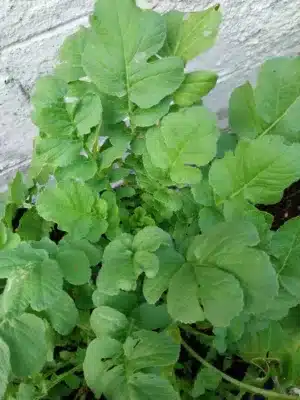Radish Leaves Revival: Exploring the Culinary Delights and Health Benefits and Nutrients
Moolee Ke Patte in Hindi & Mullangi Keerai in Tamil


All Images of Indian Organic Radish Leaves from my Container Gardening
Table of Contents
Origin 'n' definition
Radish leaves refer to the green, leafy part of the radish plant that grows above the ground. These leaves are attached to the edible root portion of the radish. While radish roots are commonly consumed as a crunchy vegetable with a peppery taste, the leaves are also edible and can be used in various culinary applications.
Its leaves are rich in nutrients such as vitamins A, C, and K, as well as minerals like calcium and iron. They have a slightly bitter and peppery flavor, similar to the radish root. Some people use radish leaves in salads, soups, or stir-fries. Including both the root and the leaves in your diet can provide a broader range of nutrients and flavors.
The Raphanus sativus the bio name is believed to have originated in Southeast Asia, likely in China. It has a long history of cultivation and has been grown for thousands of years in various parts of the world. They are now widely cultivated and consumed globally, with numerous varieties and colors available. They belong to the Brassicaceae family, which also includes cabbage, broccoli, and mustard.
Nutrients
Radish leaves often get discarded, but they’re actually a nutritional powerhouse! Here’s a breakdown of some key nutrients they offer:
Vitamins:
Vitamin C: A whopping 6 times more than the radish itself! This boosts your immune system, fights off seasonal allergies, and might even help with Covid-19.
Vitamin A: Great for eye health and overall vision.
Vitamin K: It helps and good for blood clotting and keeps you bone very healthy.
B vitamins: B1 (thiamine), B6 (pyridoxine), and B9 (folic acid) crucial for energy metabolism, nervous system function, and red blood cell production.
Minerals:
Iron: Helps prevent anemia and keeps your blood oxygenated.
Potassium: Lowers blood pressure and supports healthy nerve and muscle function.
Calcium: Builds and strengthens bones and teeth.
Magnesium: Involved in over 300 biochemical reactions in your body, crucial for energy production, muscle function, and blood sugar control.
Other benefits:
High in fiber: Aids digestion and gut health.
Rich in antioxidants: Protects your cells from damage and reduces the risk of chronic diseases.
May improve memory: Studies suggest the compound erucamide in radish leaves could help with cognitive function.
So, why not give radish leaves a chance? They have a peppery, mustard-like flavor and can be enjoyed raw in salads, steamed as a side dish, or used in chutneys, rotis, and raita.
Bonus tip: Look for organic radish leaves, as they’re more likely to be free of pesticides and nitrates.


Health Benefits
Radish leaves, often tossed aside, pack a powerful punch of health benefits beyond just their impressive nutrient profile. Here are some key ways they can contribute to your well-being:
Immune System Booster:
The abundance of vitamin C acts as a shield, protecting you from various infections and seasonal illnesses like cold and cough.
Vitamin A further strengthens your immune cells, potentially warding off chronic diseases like cancer and diabetes.
Digestive Delight:
The high fiber content promotes healthy digestion, preventing constipation and aiding in smooth gut function.
Some studies suggest a potential for radish juice to help prevent stomach ulcers.
Anemia Ally:
The rich iron content in radish leaves fights against iron deficiency and its associated symptoms like fatigue and weakness.
This makes them particularly beneficial for people with anemia or pregnant women who need extra iron.
Heart Health Hero:
Some studies indicate its leaves may help lower blood pressure by promoting excretion of sodium and potassium.
The antioxidant properties protect your heart from damage and reduce the risk of chronic heart diseases.
Brainpower Buddy:
Recent research suggests the presence of erucamide in radish leaves could potentially improve cognitive function and memory.
This makes them a promising addition to a diet focused on brain health and preventing age-related decline.
Detox Delight:
The antimicrobial and antioxidant properties of radish leaves help flush out toxins and impurities from your body.
This contributes to overall blood purification and keeps your liver and kidneys functioning efficiently.
Weight Management Friend:
Low in calories and high in fiber, radish leaves offer a satiating snack or side dish without adding substantial weight.
Their inclusion in your diet can promote a feeling of fullness and potentially aid in weight management efforts.
These are just some of the many health benefits associated with leaves. So, don’t hesitate to give them a try! Not only are they incredibly nutritious, but they also add a delicious peppery zing to your dishes. Remember, you can enjoy them raw in salads, cooked as a side dish, or incorporated into various culinary creations like chutneys, rotis, and raita.
